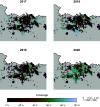Reconsidering indoor residual spraying coverage targets: A retrospective analysis of high-resolution programmatic malaria control data
- PMID: 40228135
- PMCID: PMC12037036
- DOI: 10.1073/pnas.2421531122
Reconsidering indoor residual spraying coverage targets: A retrospective analysis of high-resolution programmatic malaria control data
Abstract
Indoor residual spraying (IRS) is one of the core vector control interventions available to malaria control programs. Normative and scientific guidance has long held that very high IRS coverage (at least 80 to 85% houses sprayed) is necessary to provide community protection, but there is little evidence backing these recommendations, in large part due to the operational and ethical concerns that conducting appropriate trials of differing IRS coverage levels would raise. The present study leverages data from four years of targeted IRS implementation on Bioko Island, Equatorial Guinea, to estimate a dose-response curve of IRS coverage. Due to the observational nature of the data, a double robust causal inference technique was utilized. The results suggest that at all spatial scales examined a threshold providing community protection was reached at much lower coverage levels than previously assumed (30 to 50%). Sensitivity analysis corroborated this result across multiple methods, but there was less agreement on whether extremely high coverage ([Formula: see text]85%) has additional benefit. A secondary analysis of the impact of changing operational coverage targets found that significantly reducing coverage targets (to 30 to 60%) could provide nearly the same protection as maintaining the existing 80% target in Bioko. While these findings are limited in strength by the observational nature of the data and may be specific to the context of Bioko Island, they raise important questions for further research on how IRS coverage impacts epidemiological outcomes and on how malaria control programs should set programmatic IRS coverage targets.
Keywords: indoor residual spraying; malaria; vector control.
Conflict of interest statement
Competing interests statement:The authors declare no competing interest.
Figures




Similar articles
-
Increased risks of malaria due to limited residual life of insecticide and outdoor biting versus protection by combined use of nets and indoor residual spraying on Bioko Island, Equatorial Guinea.Malar J. 2012 Jul 26;11:242. doi: 10.1186/1475-2875-11-242. Malar J. 2012. PMID: 22835049 Free PMC article.
-
How much does malaria vector control quality matter: the epidemiological impact of holed nets and inadequate indoor residual spraying.PLoS One. 2011 Apr 29;6(4):e19205. doi: 10.1371/journal.pone.0019205. PLoS One. 2011. PMID: 21559436 Free PMC article.
-
Evaluation of the residual effectiveness of Fludora™ fusion WP-SB, a combination of clothianidin and deltamethrin, for the control of pyrethroid-resistant malaria vectors on Bioko Island, Equatorial Guinea.Acta Trop. 2019 Aug;196:42-47. doi: 10.1016/j.actatropica.2019.05.006. Epub 2019 May 8. Acta Trop. 2019. PMID: 31077641
-
Combining indoor residual spraying and insecticide-treated net interventions.Am J Trop Med Hyg. 2009 Sep;81(3):519-24. Am J Trop Med Hyg. 2009. PMID: 19706925 Free PMC article. Review.
-
A review of selective indoor residual spraying for malaria control.Malar J. 2024 Aug 23;23(1):252. doi: 10.1186/s12936-024-05053-3. Malar J. 2024. PMID: 39175014 Free PMC article. Review.
Cited by
-
Testing indoor residual spraying coverage targets for malaria control, Bioko, Equatorial Guinea.Bull World Health Organ. 2025 Jun 1;103(6):392-402. doi: 10.2471/BLT.24.292505. Epub 2025 May 3. Bull World Health Organ. 2025. PMID: 40511394 Free PMC article.
References
-
- World Health Organization Interim Commission, “Expert committee on malaria: Report on the first session” (Tech. Rep. WHO.IC/Mal/4, World Health Organization, 1947).
-
- E. J. Pampana, “Large scale malaria control campaigns using residual insecticides” (Tech. Rep. WHO/MAL/46, World Health Organization, 1950).
-
- Griffith M. E., The world-wide malaria eradication program. Bull. Entomol. Soc. Am. 12, 130–136 (1966).
MeSH terms
Substances
Grants and funding
LinkOut - more resources
Full Text Sources
Medical

